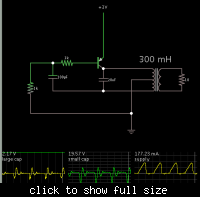Weylin
Newbie level 6

Hello, first post here, so I apologize if this is the wrong section, or if this has been resolved before (Google searches didn't lead me to any possible solutions, or I don't know the right key words)
I was trying out some of the circuits from my old electronic project labs, the kind with the little spring terminals, such as this one "**broken link removed**"
The circuit in particular I'm trying is on page 15 on the right side of that PDF.
I'm trying to simulate this in LTSpice, but it's not oscillating like it should. That, or this type of circuit simply doesn't work with 'perfect' models, or there is some aspect of the circuit that is not being simulated.
Here's an image of what I have, I'm not entirely sure what inductance the transformer should have, or if I even did that part properly, because the transformer is key to this oscillator functioning.

full size image: https://i50.tinypic.com/2h55rwi.png
I was trying out some of the circuits from my old electronic project labs, the kind with the little spring terminals, such as this one "**broken link removed**"
The circuit in particular I'm trying is on page 15 on the right side of that PDF.
I'm trying to simulate this in LTSpice, but it's not oscillating like it should. That, or this type of circuit simply doesn't work with 'perfect' models, or there is some aspect of the circuit that is not being simulated.
Here's an image of what I have, I'm not entirely sure what inductance the transformer should have, or if I even did that part properly, because the transformer is key to this oscillator functioning.

full size image: https://i50.tinypic.com/2h55rwi.png



